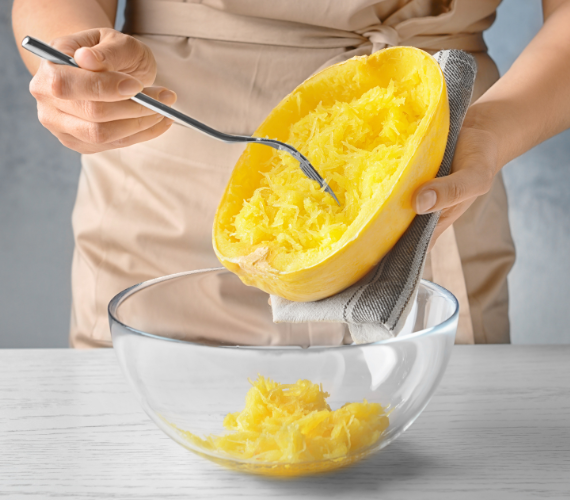Mrs. Chef Recommends…
 Buy Now →
Buy Now →  Buy Now →
Buy Now →  Buy Now →
Buy Now →  Buy Now →
Buy Now → When you buy through any affiliate links on our site (i.e. Amazon), we may earn an affiliate commission. Happy shopping!

How to Cook Spaghetti Squash
Description
Spaghetti Squash is a hard-skinned squash, with peak growing season in the winter, but available year-round with a long shelf-life. It’s flesh, when cooked, separates into long strands very similar to spaghetti, hence the name.
Spaghetti squash is very mild in flavor and lends well to savory dishes across many different cuisines. It can be used as a base ingredient for a main dish (partnered with a protein) or as a vegetable side dish.
The best cooking methods are steamed, microwaved, or roasted. Spaghetti squash is best cooked slightly al dente, especially if you will be continuing to cook it further with additional ingredients.
This MASTER RECIPE contains a selection of possible ingredients and flavors that work well with Spaghetti Squash.
MIX & MATCH your flavors, using the recipe guide below, to build your own unique dish.
INGREDIENTS
Starring Role – The Squash
Supporting Roles – Possible Proteins
Side Roles – Veritable Veggies
Background – Awesome Aromatics
Featured – Successful Sauces
Extras – Even More Flavor/Texture
METHOD
-
Decide Cooking Method and Size
Choose between roasting, steaming, boiling, microwaving.
Conveniently, spaghetti squash can double-duty as its own serving dish, when simply cut in half lengthwise. If microwaving or steaming, it is best to cut the squash into 1/4’s or 1/8’s for more manageable sizes and quicker cooking times.
-
Cut Open and Remove Seeds
Spaghetti squash has a hard skin that needs to be split with a large sharp knife, preferably an 8-10″ French chef’s knife or Japanese Santoku or Nakiri vegetable knife. Using a large spoon, scrape out the seeds and discard.
-
Cooking
When roasting, place cut side down on parchment lined baking sheet in 400° oven, may season the cut side with butter/olive oil, salt and pepper in advance. Depending upon the size of the spaghetti squash and whether cut into larger or smaller chunks, cook times will vary. On average estimate 30-40 minutes, until flesh is soft and can be flaked away into strands with a fork.
When steaming, place in steamer in a steamer basket over boiling water; cover. Steam until tender.
When microwaving, place in microwave safe glass dish and cover. Microwave in 8-10 minutes until tender.
-
Par Cooking
If you are short on time and want a roasted spaghetti squash, before roasting, you may start the process by partially cooking it in the microwave. Prepare and microwave for about 5 minutes. Then continue by finishing it in the oven for a roasted flavor.
-
Combination Cooking
After the squash has been prepared and cooked with a steaming, boiling or microwave method, you may remove the strands of squash and finish them further in a hot pan with butter/oil, additional vegetables, aromatics and sauce.
-
Plating and Serving
Preheat dishes in oven or microwave. With tongs, a spaghetti fork or large spoon, place a mound of the squash in the center of plate, place any proteins on top with additional sauce and extras. You may also leave it in it's shell and simply transfer it from the pan to the dish. Top as desired.
Note
CREATIVE COMBINATIONS
Creamy Garlic & Mushroom: Microwave the squash with a light dusting of salt and pepper. Remove squash strands from shell. Sauté minced shallots and chopped garlic and mushrooms in butter and olive oil; add a couple turns of vermouth to deglaze the bottom of pan. Add cooked spaghetti squash and toss. Add just enough cream to coat and a generous dousing of parmesan, heat through.
Marinara: Sauté cooked strands in garlic and olive oil, season with salt and pepper. Place in center of plate, top with marina and meatballs or spicy meat sauce and a generous dusting of fresh Parmesan cheese. Serve with a side of crusty garlic bread.

